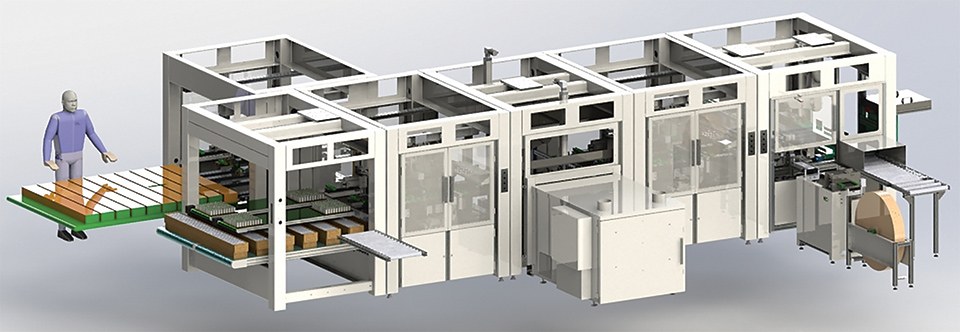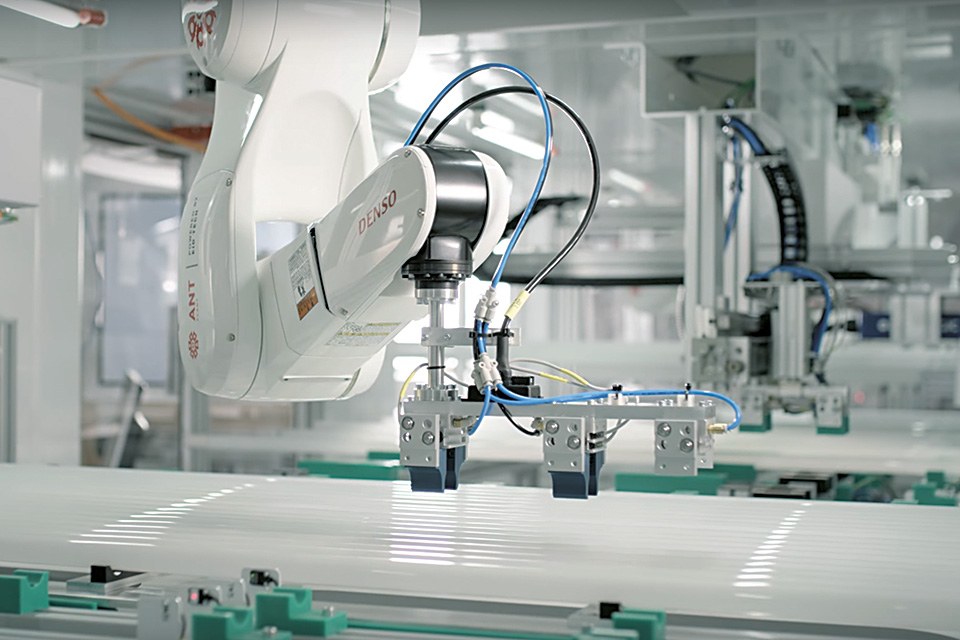A Manufacturing Revolution for the LED Lighting Industry
LpR 67 Article, page 76: Western business investments in local manufacturing facilities have been declining since the 1980s due to partnering with contract manufacturers in Asia. But with increasing and hidden costs in Asia, companies are now seeking to bring manufacturing back home. A recent innovation, microfactories, could be the solution. Paavo Käkelä, Chairman and VP at EID Tech in Finland, presents the microfactory called Ant PlantTM. He explains this new, flexible manufacturing concept, shows how it works and how it is set up, and analyzes the benefits of local, automated production of LED lighting products as an alternative to contract manufacturing in Asia.
Companies have been in search for better profits and lower labor costs through contract manufacturing in Asia. During the last decade, however, Chinese labor cost has risen with an increase of 64% since 2011 [1]. Due to this trend, some companies are now taking their business elsewhere with lower wages, or considering automation, to secure competitive production cost. When also considering all hidden costs of overseas contract manufacturing, including the import taxes, customs fees and freight expenses, many companies have realized that it is more reasonable to bring the manufacturing back home to automated factories, instead of searching for another low-cost labor country.
New Unpredictable Risks Emerging in Global Markets
US Manufacturers are voicing concerns about the downside of the import tariffs the Trump administration is slapping on $50 billion worth of Chinese products. At the same time, there are talks about potential changes in NAFTA. And who knows, maybe even EU relations will become volatile if the worst-case trade-war scenarios play out.
Many of the manufacturing business leaders have no way of predicting how all this will impact their business in the long term. Political risks, corruption, changes to the tariffs, supply chain costs, changing exchange rates, a need for big committed capital for the advance payments for outsourcing partners, long lead times, quality risks, etc. Nobody can accurately forecast the global market behavior and its impact on one single business.
It's like driving in fog down a busy highway with no headlights. At the same time, manufacturing CEOs need to continue developing their strategy and make sound investment decisions.
Automation is Here to Help
One way to reduce the risk of unpredictable global markets, is to bring manufacturing back home. With today’s automated production line solutions, it is becoming a real option to run a successful and profitable manufacturing business without outsourcing it to Asia.
EID Tech, a manufacturing automation company, has spent the last four years in developing the entirely new concept called Ant Plant™ Microfactory. It is an example of the new trend, where the local manufacturing operations are made profitable again, thanks to a new reasonably priced automation and robotic production solutions.
The microfactory concept has the potential to change the way the LED lighting industry is manufacturing its products. The field-data from the first LED Lighting microfactory owners demonstrate that it can reduce the local manufacturing cost to a competitive level vs. Asian imports. It also makes manufacturing more flexible, with faster lead times and rapid small batch product runs. By using fully automated manufacturing with automated burn-in and testing, the microfactory also substantially increases the quality of the LED lighting products, as all the products are 100% tested and human errors are eliminated.
Factory as a Service Brings Additional Benefits
Companies investing in production line automaton are often worried about their long term operations. What happens, for example, if they suddenly have to modify or change the product design?
By using a well modularized system, updates are easy to make when product modifications require changes in the assembly setup. Fully automated microfactory operations are controlled from the cloud and field engineers can be supported remotely to make any changes at customer premises with minimum downtime to the operation.
When new updated parts or components are needed, and if they are different size or form factor, vision-guided general feeders enable quick and easy changes to new parts.
Most of the updates can be done remotely from the microfactory service center with the help of customer’s engineers. To secure optimized and uninterrupted operation, the product line data is continuously collected and analyzed in the cloud. If any deviations appear in the process, corrective actions are prepared remotely and the required service can be often done even without stopping the production.
Brief Description of a Modularized Microfactory
A fully automated microfactory line, for example for LED Tube production, has six main modules (Figure 1).
 Figure 1: Microfactory with the complete line
Figure 1: Microfactory with the complete line
The six main modules for an LED Tube production:
• Loading (1)
• Assembly1 (2)
• Assembly2 (3)
• Aging (4)
• Testing & laser marking (5)
• Individual / serial packaging (6)
Customers can choose a combination of these modules that will best fit their manufacturing needs. For example, if the setup only calls for sample-based offline testing, and there is already an offline packing line in the factory, the assembly and the laser marking functions may be all that is needed. In that case, only the first three microfactory modules and the laser marking and unloading modules are required (Figure 2). Additional modules can be added later, if aging, testing and packaging need to be added. The set-up time for installing new modules to the line is on average only two hours until production is running again. The modular design also makes it possible to make the investment in the microfactory in smaller installments.
 Figure 2: Simpler example of the microfactory, just using the loading, assembly and laser marking + unloading modules
Figure 2: Simpler example of the microfactory, just using the loading, assembly and laser marking + unloading modules
Installation of the complete microfactory line at customer premises can be done in only eight hours because the interface between the modules is just connecting the power lines and communication network. During the installation the robot picking and placing points will be prepared and tested, and then the production can start running.
With the best microfactory setup, not only the production line is modularized. All the applications inside the cell are also their own individual modules. The line also has its own communication network with one secured external connection point for remote control and data collection. All the applications have their own I/O modules and are connected with Fieldbus, so they are easy to change when required due to product design changes. Robots are placed on the cell ceiling, which allows maximum space for applications working area inside the cell. The application and control software is also modularized to each function and application.
The microfactory line is controlled from Graphical User Interface (GUI) (Figure 3). The GUI has different user access levels, which are defined together with the customer. The operator can run the line and monitor the cell states, yield and output. Any changes to settings, when product type is changed, can be done by advanced user. Production engineers can also easily change settings and make service and maintenance actions when needed.
 Figure 3: A Graphical User Interface simplifies monitoring, controlling and operating of the plant
Figure 3: A Graphical User Interface simplifies monitoring, controlling and operating of the plant
Quality Improvements that Only Robots Can Guarantee
Quality of a product has three critical components: Product design, used materials and manufacturing process. To make sure that the automated production can run efficiently in most of the cases DFA (Design For Automation) work is needed.
During the DFA planning the critical points in the product architecture are defined to ensure the best possible manufacturability and production output, with minimum compromises in product design. DFA work connects the manufacturing process and product together.
When the product design and manufacturing process are properly prepared and designed, when the needed test points are defined, possible human errors are minimized, and only the validated material suppliers are used, it is possible to achieve an extremely high level of product quality. And that quality is made possible by preparing the process and product design before manufacturing, with full automated production and tests, and not by quality monitoring later on by the operators during the process.
Logistics and Supply Chain - Automated
Offering a centralized regional hub that will feed product parts and materials to remote microfactories, will help to secure larger purchasing volumes and cost reduction for product parts. That benefit is then shared with all the microfactory users that are using the service. The regional hub concept makes the short lead times to parts possible and reduces manufacturer’s inventory cost. Compare that to an outsourced Asian operation, that may require large quantity orders, with prepayment and long lead times.
Microfactory Has Its First Focus on the LED Lighting Industry
While the same microfactory concept can be applied to any high volume production of small size merchandize that requires assembly, it is planned first to serve the LED lighting markets. Manufacturing LED tubes, fixtures and panels, seems to be ideally fitted for gaining the benefits of the microfactory operation, and the feedback from the first customers has been encouraging.
As LED lighting products continue becoming more standardized and price competition intensifies, the pressure to lower manufacturing costs continue to increase. Microfactory technology offers the local based LED lighting companies a new flexibility, better customer response-times, the quality and cost that will help them to stay competitive for the long- term future. With fully automated microfactory solution, today, even smaller western LED lighting companies can run profitable and flexible manufacturing at home, closer to their own market and customers.
Local Wellbeing
Even if microfactory operations are 100% automated, they always provide people with work – for instance, to support the manufacturing and handle human– robot collaboration. While a fully automated and intelligent microfactory doesn’t need people to assemble or package the products, someone still has to do specialist work or work which is needed for production support functions. Technological advances in tools for engineering already make it necessary to have a college degree in many types of manufacturing jobs. This development brings new possibilities for millions of workers with skills in advanced machinery in the near future.
Conclusions
LED lighting manufacturers can gain several benefits by using the micro-factory concept. Microfactories offer both business and national economic benefits due to several reasons.
Benefits of micro-factories:
• Flexible manufacturing:
Full control over local production line enables rapid response to customer
demand, and optimized end-product inventory with lower working capital
need
• Competitive cost:
With a fully-automated microfactory, operated by one person, the product
cost is competitive with Asian imports
• Superior quality:
With micro-factory’s automated product burn-in and testing capabilities,
the human error factor is minimized. Micro-factory users have reported
3x lower field failure rate and 3x longer product life vs. Asian contract
manufacturing
• Local and green:
Local manufacturing supports vibrant local partner ecosystem
development around the microfactory operations and enables building
a local brand, for example “Made-in-USA”
Using microfactories like Ant Plant™ may not be the only required action to keep and improve competitiveness of our western industry, but it can be a significant contribution to it. Furthermore, this concept allows smaller companies and start-ups to set up their own production with relatively little cost, and by that may enable new creativity and new ideas.

